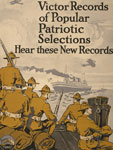Florida: Kindergarten Standards
-
FL.SS.K.A.1 Standard / Body Of Knowledge: Historical Inquiry and Analysis [American History]
-
SS.K.A.1.1 Benchmark / Big Idea:
Develop an understanding of how to use and create a timeline.
SS.K.A.1.1 Benchmark / Descriptor:
Put in order three things that happened during the school day.
-
SS.K.A.1.2 Benchmark / Big Idea:
Develop an awareness of a primary source.
-
SS.K.A.1.2 Benchmark / Descriptor:
Examples may include photographs, a letter from a grandparent, or artifacts.
-
-
-
FL.SS.K.A.2 Standard / Body Of Knowledge: Historical Knowledge [American History]
-
SS.K.A.2.1 Benchmark / Big Idea:
Compare children and families of today with those in the past.
-
SS.K.A.2.1 Benchmark / Descriptor:
An example is family life now versus family life when grandparents were young.
-
-
SS.K.A.2.2 Benchmark / Big Idea:
Recognize the importance of celebrations and national holidays as a way of remembering and honoring people, events, and our nation's ethnic heritage.
-
SS.K.A.2.2 Benchmark / Descriptor:
Examples are Veteran's Day, Thanksgiving, Martin Luther King Jr. Day, President's Day, Memorial Day, Independence Day [4th of July], Cinco de Mayo and birthdays.
-
-
SS.K.A.2.3 Benchmark / Big Idea:
Compare our nation's holidays with holidays of other cultures.
-
SS.K.A.2.3 Benchmark / Descriptor:
Independence days are different in other countries.
-
-
SS.K.A.2.4 Benchmark / Big Idea:
Listen to and retell stories about people in the past who have shown character ideals and principles including honesty, courage, and responsibility.
-
SS.K.A.2.4 Benchmark / Descriptor:
Examples are Pocahontas, George Washington, Abraham Lincoln, Martin Luther King, Jr., Harriet Tubman, and astronauts.
-
-
SS.K.A.2.5 Benchmark / Big Idea:
Recognize the importance of U.S. symbols.
-
SS.K.A.2.5 Benchmark / Descriptor:
Examples are the Statue of Liberty, the bald eagle, the Star Spangled Banner, and national and state flags.
-
-
-
FL.SS.K.A.3 Standard / Body Of Knowledge: Chronological Thinking [American History]
-
SS.K.A.3.1 Benchmark / Big Idea:
Use words and phrases related to chronology and time to explain how things change and to sequentially order events that have occurred in school.
-
SS.A.3.1.1 Benchmark / Descriptor:
Examples are before, after; morning, afternoon, evening; today, tomorrow, yesterday; past, present, future; last week, this week, next week; day, week, month, year.
-
-
SS.A.3.1.2 Benchmark / Big Idea:
Explain that calendars represent days of the week and months of the year.
-
-
FL.SS.K.C.1 Standard / Body Of Knowledge: Civics and Government [Foundations of Government, Law, and the American Political System]
-
SS.K.C.1.1 Benchmark / Big Idea:
Define and give examples of rules and laws, and why they are important.
-
SS.K.C.1.1 Benchmark / Descriptor:
Examples are standing in line at school and wearing a bike helmet.
-
-
SS.K.C.1.2 Benchmark / Big Idea:
Explain the purpose and necessity of rules and laws at home, school, and community.
-
SS.K.C.1.2 Benchmark / Descriptor:
Examples are attending school and wearing a seat belt.
-
-
-
FL.SS.K.C.2 Standard / Body Of Knowledge: Civic and Political Participation [Foundations of Government, Law, and the American Political System
-
SS.K.C.2.1 Benchmark / Big Idea:
Demonstrate the characteristics of being a good citizen.
-
SS.K.C.2.1 Benchmark / Descriptor:
Examples are taking turns, sharing, taking responsibility, following rules, understanding the consequences of breaking rules, practicing honesty, self-control, and participating in classroom decision making
-
-
SS.K.C.2.2 Benchmark / Big Idea:
Demonstrate that conflicts among friends can be resolved in ways that are consistent with being a good citizen.
-
SS.K.C.2.3 Benchmark / Big Idea:
Describe fair ways for groups to make decisions.
-
SS.K.C.2.3 Benchmark / Descriptor:
Examples are voting, taking turns, and coming to an agreement.
-
-
-
FL.SS.K.E.1. Standard / Body Of Knowledge: Beginning Economics [Economics]
-
SS.K.E.1.1 Benchmark / Big Idea:
Describe different kinds of jobs that people do and the tools or equipment used.
-
SS.K.E.1.1 Benchmark / Descriptor:
Examples are community helpers, firefighter and fire truck.
-
-
SS.K.E.1.2 Benchmark / Big Idea:
Recognize that United States currency comes in different forms.
-
SS.K.E.1.2 Benchmark / Descriptor:
Examples are coins and bills.
-
-
SS.K.E.1.3 Benchmark / Big Idea:
Recognize that people work to earn money to buy things they need or want.
-
SS.K.E.1.4 Benchmark / Big Idea:
Identify the difference between basic needs and wants.
-
SS.B.1.1.4 Benchmark / Descriptor:
Examples of needs are clothing and shelter and examples of wants are video games and toys.
-
-
-
FL.SS.K.E.1 Standard / Body Of Knowledge: The World in Spatial Terms [Geography]
-
SS.K.G.1.1 Benchmark / Big Idea:
Describe the relative location of people, places, and things by using positional words.
-
SS.K.G.1.1 Benchmark / Descriptor:
Examples are near/far; above/below, left/right and behind/front.
-
-
SS.K.G.1.2 Benchmark / Big Idea:
Explain that maps and globes help to locate different places and that globes are a model of the Earth.
-
SS.K.G.1.3 Benchmark / Big Idea:
Identify cardinal directions (north, south, east, west).
-
SS.K.G.1.4 Benchmark / Big Idea:
Differentiate land and water features on simple maps and globes.
-
SS.K.G.1.4 Benchmark / Descriptor:
Examples are blue is water and green/brown is land.
-
-
-
FL.SS.K.G.2 Standard / Body Of Knowledge: Places and Regions [Geography]
The student understands the structure, functions, and purpose of government and how the principles and values of American democracy are reflected in American constitutional government.
-
SS.K.G.2.1 Benchmark / Big Idea:
Locate and describe places in the school and community.
-
SS.K.G.2.1 Benchmark / Descriptor:
Examples are the cafeteria, library, office, restrooms, and classroom.
-
-
SS.K.G.2.2 Benchmark / Big Idea:
Know one's own phone number, street address, city or town and that Florida is the state in which the student lives.
-
-
FL.SS.K.G.3 Standard / Body Of Knowledge: Physical System [Geography]
The student understands the role of the citizen in American democracy.
-
SS.K.G.3.1 Benchmark / Big Idea:
Identify basic landforms.
-
SS.K.G.3.1 Benchmark / Descriptor:
Examples are hills, forests, wetlands, and coasts.
-
-
SS.K.G.3.2 Benchmark / Big Idea:
Identify basic bodies of water.
-
SS.K.G.3.2 Benchmark / Descriptor:
Examples are rivers, lakes, oceans, and gulfs.
-
-
SS.K.G.3.3 Benchmark / Big Idea:
Describe and give examples of seasonal weather changes, and illustrate how weather affects people and the environment.
-


